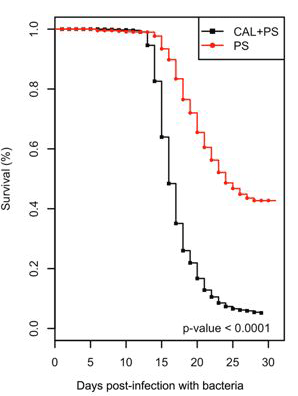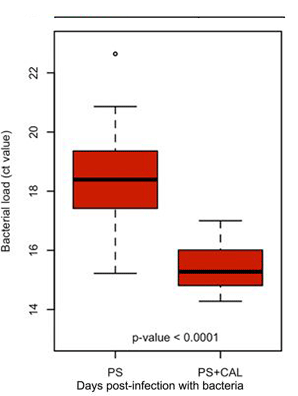Vaccination is considered crucial for disease prevention and fish health in the $6 billion USD global salmon farming industry, which now produces over 50 per cent of the fish required for human consumption. The use of vaccines against bacterial, viral and parasitic pathogens that cause the most common fish diseases has expanded greatly in the last 10 years. Nevertheless, researchers are finding that vaccines seem to provide little protection during co-infection – when two or more pathogens jointly wreak havoc on fish immune systems.
Sea lice are frequently found in co-infection with other pathogens, and have the greatest economic impact of any parasite on salmon farming. They typically injure fish skin with their rasping mouthparts, and subsequently weaken the protective barrier between the fish and their environment. Under stress, the fish become vulnerable to other pathogens and their immune systems become further compromised.
Although there is substantial research gauging how effective vaccines are on fish infected with a single pathogen, studies on co-infections have only recently gained interest; ours is the first study of its kind to address how a parasite in fish can override the protective effects of a vaccine for another disease.
Our study was conducted in Chile where its aquaculture industry was nearly wiped out by Infectious Salmon Anaemia Virus in 2008 and where vaccines make up as much as 30 per cent of the country’s total production cost. Vaccines are required to prevent over-use of antibiotics and to avoid devastating losses from reoccurring disease. Sea lice are problematic there, especially when they cause secondary infections by bacteria and viruses.
Methodology
Together with researchers from the Pontifical Catholic University of Valparaiso and Chile’s University of Valparaiso, one of whom completed his PhD at Waterloo in my laboratory, we tested the efficacy of the vaccine for the bacterial pathogen Piscirickettsia salmonis. We compared how vaccinated Atlantic salmon (Salmo salar) responded when exposed either to the bacteria alone or to co- infection with a combination of the bacteria and the sea louse Caligus rogercresseyi in the lab.
Vaccinated fish of two different Salmo salar populations were provided for this study by the salmon fish farming company Salmones Camanchaca. During the salmon freshwater growth period they were vaccinated twice using commercial vaccines, following the strict protocols of the company. First, they were vaccinated against two viruses. Second, they were vaccinated against P. salmonis at the same time as the first vaccination. Then, they were transferred as smolts to the Aquadvice experimental station in Puerto Montt, Chile. We also included a control group of fish that were not vaccinated.
Outcomes
Our results showed that infection with sea lice and P. salmonis together decreased the accumulated survival and specific growth rate of vaccinated fish when compared to infection with P. salmonis alone. Fifty percent of the fish infected with only bacteria survived the infection, while almost all fish infected with both bacteria and sea lice died (see Fig. 1).

Figure 1: Survival curve according to type of infection. Abbreviations: CAL+PS: coinfection with both C. rogercresseyi and P. salmonis; PS: single infection with P. salmonis.
Interestingly, co-infected fish contained less bacteria even though the clinical signs of disease were significantly increased in those fish (Fig. 2), suggesting the bacteria were much more pathogenic in co-infected fish despite the vaccination they had received.

Figure 2: Bacterial load in moribund fish collected at 50 per cent mortality per type of infection.
Conclusions
Fish vaccination is considered crucial in global fish aquaculture, but unfortunately efficacy in the field may be limited by different factors such as temperature, stress and the transient nature of the adaptive immunity in fish. This study provides evidence, for the first time, that infection with sea lice can override the protective effects of vaccination against a bacterial pathogen in Atlantic salmon, reducing the survival and growth of vaccinated fish and concomitantly increasing clinical signs of disease when compared to fish with a single infection.
Parasitic infections can contribute to the severity of some infectious diseases, especially those caused by bacteria. Beyond the fact that parasites create wounds that allow bacteria and viruses to enter the fish and bypass natural defenses, parasitic infections may divert the fish immune response and alter fish physiology, decreasing resistance to other diseases. This study shows that co-infection of pathogens and parasites could decrease the resistance of fish against a bacterial infection, even when the fish have been specifically vaccinated against that bacteria. Co-infection with sea lice essentially removed the protective effects of vaccination indicating that effective treatments for sea lice, as well as vaccines that induce more effective and long-lasting immune responses are essential to protect an industry that provides seafood for much of the globe.
Figueroa, C., Bustos, P., Torrealba, D., Dixon, B., Soto, C., Conejeros, P. & Gallardo, J.A. (2017). Coinfection takes its toll: Sea lice override the protective effects of vaccination against a bacterial pathogen in Atlantic salmon. Scientific Reports, 7, 17817.
Contact: Brian Dixon, Department of Biology
For more information about WaterResearch, contact Amy Geddes.







